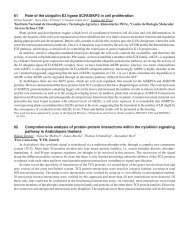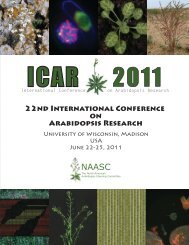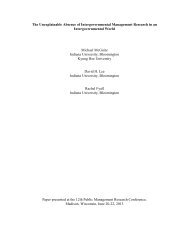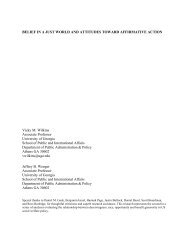PROGRAM & ABSTRACTS - Wisconsin Union - University of ...
PROGRAM & ABSTRACTS - Wisconsin Union - University of ...
PROGRAM & ABSTRACTS - Wisconsin Union - University of ...
You also want an ePaper? Increase the reach of your titles
YUMPU automatically turns print PDFs into web optimized ePapers that Google loves.
Aging, Metabolism, Stress, Pathogenesis, and Small RNAs in C. elegans Topic Meeting 2012<br />
Functions <strong>of</strong> MicroRNAs During Aging<br />
Alexandre de Lencastre, Frank Slack<br />
Yale <strong>University</strong>, New Haven, CT, USA<br />
MicroRNAs (miRNAs) function to regulate gene expression during development in higher<br />
eukaryotes. Previous work in our lab has demonstrated that miRNAs <strong>of</strong> previously unknown<br />
function, such as miR-71, miR-238, miR-239 and miR-246 function during adulthood to promote<br />
or antagonize longevity and stress response in C. elegans (1). We found that these miRNAs are<br />
up-regulated in aging and genetically interact with components <strong>of</strong> the insulin signaling pathway<br />
and the DNA damage checkpoint response pathway. Together with our previous observation<br />
that mutations to the miRNA lin-4 and its target lin-14 significantly affect the lifespan <strong>of</strong> C.<br />
elegans (2), these results establish miRNAs as a new class <strong>of</strong> aging-associated genes, with<br />
the potential to interact with a wide range <strong>of</strong> aging pathways.<br />
In order to understand the biological function <strong>of</strong> these age-associated miRNAs, we have<br />
begun characterizing the factors downstream as well as upstream <strong>of</strong> these miRNAs that mediate<br />
their function. We have shown by genetic epistasis that the insulin-signalling and the DNA<br />
damage response pathways interact with miR-71 and miR-239. In order to characterize the<br />
detailed molecular identities <strong>of</strong> pathway genes that may transduce these miRNAs’ functions,<br />
we have surveyed the mRNA expression levels <strong>of</strong> multiple genes in these pathways in the<br />
genetic background <strong>of</strong> aging-associated miRNA mutants. We have found significantly deregulated<br />
expression <strong>of</strong> candidate targets genes in these pathways that are also predicted to<br />
be direct targets <strong>of</strong> these miRNAs. Similarly, we have also begun characterizing the identity<br />
<strong>of</strong> upstream factors that regulate the expression <strong>of</strong> our age-associated miRNAs. We have<br />
evidence that suggests that 2 well-known transcription factors regulate the expression <strong>of</strong> specific<br />
aging-associate miRNAs and suggest a possible function for these miRNAs as mediators <strong>of</strong><br />
organismal response to environmental stress. Given the high conservation <strong>of</strong> aging pathways<br />
and miRNAs across species, it is likely that insights uncovered by this research will have high<br />
relevance towards our understanding <strong>of</strong> aging in higher organisms and humans.<br />
References:<br />
1. de Lencastre A. et al., Curr Biol. 20, 1-10 (2010).<br />
2. Boehm M., Slack FJ., Science. 310, 1954-7 (2005).<br />
Contact: alexandre.delencastre@yale.edu<br />
Lab: Slack<br />
10<br />
Session 2

















